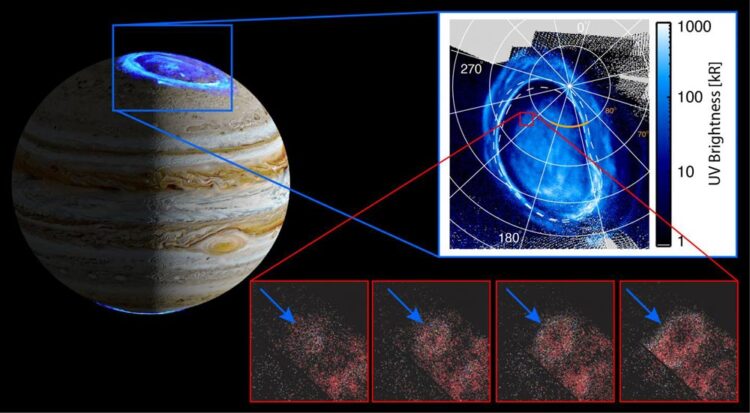SwRI scientists discover a new auroral feature on Jupiter

The SwRI-led Ultraviolet Spectrograph (UVS) orbiting Jupiter aboard NASA's Juno spacecraft allowed scientists to discover faint aurora features likely triggered by charged particles coming from the edge of Jupiter's massive magnetosphere. This occurrence, shown in the false color series of images recorded 30 seconds apart (red panels), displays the characteristically ring-like emissions, expanding rapidly over time.
Credit: NASA/SWRI/JPL-Caltech/SwRI/V. Hue/G. R. Gladstone/B. Bonfond
UVS images faint auroral rings that likely originate at edge of gas giant’s magnetosphere.
The SwRI-led Ultraviolet Spectrograph (UVS) orbiting Jupiter aboard NASA’s Juno spacecraft has detected new faint aurora features, characterized by ring-like emissions, which expand rapidly over time. SwRI scientists determined that charged particles coming from the edge of Jupiter’s massive magnetosphere triggered these auroral emissions.
“We think these newly discovered faint ultraviolet features originate millions of miles away from Jupiter, near the Jovian magnetosphere’s boundary with the solar wind,” said Dr. Vincent Hue, lead author of a paper accepted by the Journal of Geophysical Research: Space Physics. “The solar wind is a supersonic stream of charged particles emitted by the Sun. When they reach Jupiter, they interact with its magnetosphere in a way that is still not well understood.”
Both Jupiter and Earth have magnetic fields that provide protection from the solar wind. The stronger the magnetic field, the larger the magnetosphere. Jupiter’s magnetic field is 20,000 times stronger than Earth’s and creates a magnetosphere so large it begins to deflect the solar wind 2-4 million miles before it reaches Jupiter.
“Despite decades of observations from Earth combined with numerous in-situ spacecraft measurements, scientists still do not fully understand the role the solar wind plays in moderating Jupiter’s auroral emissions,” said SwRI’s Dr. Thomas Greathouse, a co-author on this study. “Jupiter’s magnetospheric dynamics, the motion of charged particles within its magnetosphere, is largely controlled by Jupiter’s 10-hour rotation, the fastest in the solar system. The solar wind’s role is still debated.”
One of the goals of the Juno mission, recently approved by NASA for an extension until 2025, is to explore Jupiter’s magnetosphere by measuring its auroras with the UVS instrument. Previous observations with the Hubble Space Telescope and Juno have allowed scientists to determine that most of Jupiter’s powerful auroras are generated by internal processes, that is the motion of charged particles within the magnetosphere. However, on numerous occasions, UVS has detected a faint type of aurora, characterized by rings of emissions expanding rapidly with time.
“The high-latitude location of the rings indicates that the particles causing the emissions are coming from the distant Jovian magnetosphere, near its boundary with the solar wind,” said Bertrand Bonfond, a co-author on this study from Belgium’s Liège University. In this region, plasma from the solar wind often interacts with the Jovian plasma in a way that is thought to form “Kelvin-Helmholtz” instabilities. These phenomena occur when there are shear velocities, such as at the interface between two fluids moving at different speeds. Another potential candidate to produce the rings are dayside magnetic reconnection events, where oppositely directed Jovian and interplanetary magnetic fields converge, rearrange and reconnect.
Both of these processes are thought to generate particle beams that could travel along the Jovian magnetic field lines, to eventually precipitate and trigger the ring auroras on Jupiter.
“Although this study does not conclude what processes produce these features, the Juno extended mission will allow us to capture and study more of these faint transient events,” Hue said.
###
The Jet Propulsion Laboratory, a division of Caltech in Pasadena, California, manages the Juno mission for the principal investigator, Dr. Scott J. Bolton, of SwRI. Juno is part of NASA’s New Frontiers Program, which is managed at NASA’s Marshall Space Flight Center in Huntsville, Alabama, for the agency’s Science Mission Directorate in Washington. Lockheed Martin Space in Denver built and operates the spacecraft.
For more information, read the paper at https:/
All latest news from the category: Physics and Astronomy
This area deals with the fundamental laws and building blocks of nature and how they interact, the properties and the behavior of matter, and research into space and time and their structures.
innovations-report provides in-depth reports and articles on subjects such as astrophysics, laser technologies, nuclear, quantum, particle and solid-state physics, nanotechnologies, planetary research and findings (Mars, Venus) and developments related to the Hubble Telescope.
Newest articles

NASA: Mystery of life’s handedness deepens
The mystery of why life uses molecules with specific orientations has deepened with a NASA-funded discovery that RNA — a key molecule thought to have potentially held the instructions for…

What are the effects of historic lithium mining on water quality?
Study reveals low levels of common contaminants but high levels of other elements in waters associated with an abandoned lithium mine. Lithium ore and mining waste from a historic lithium…

Quantum-inspired design boosts efficiency of heat-to-electricity conversion
Rice engineers take unconventional route to improving thermophotovoltaic systems. Researchers at Rice University have found a new way to improve a key element of thermophotovoltaic (TPV) systems, which convert heat…



